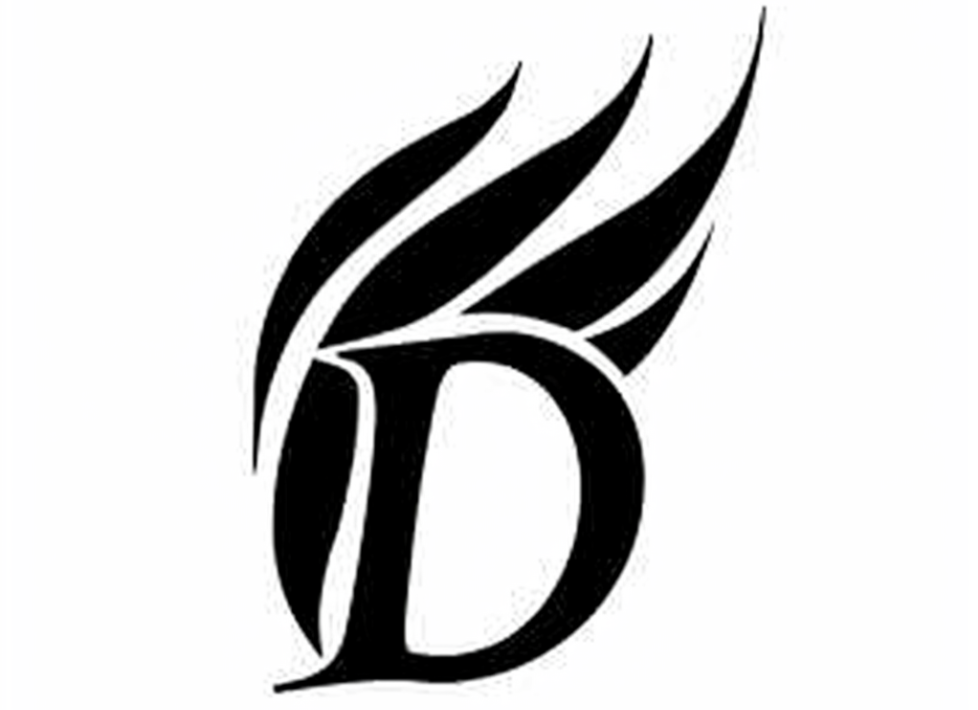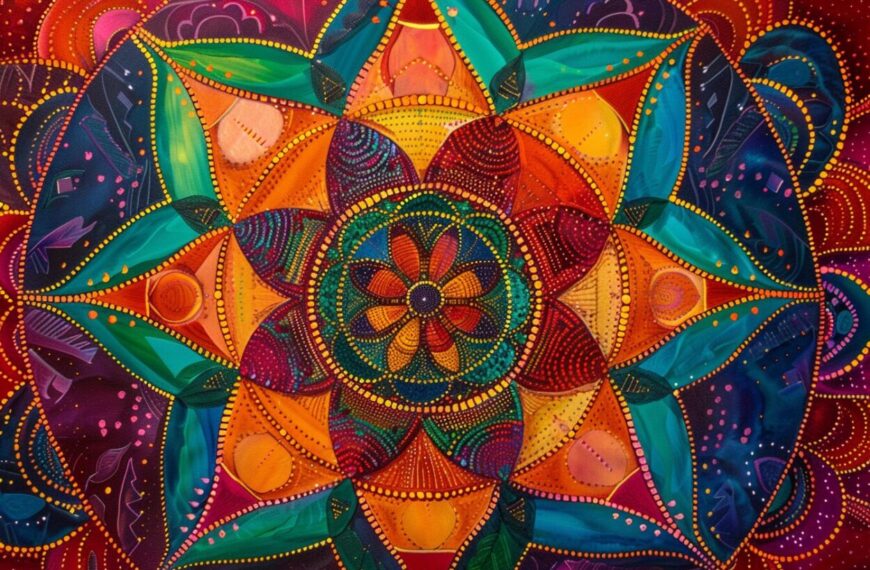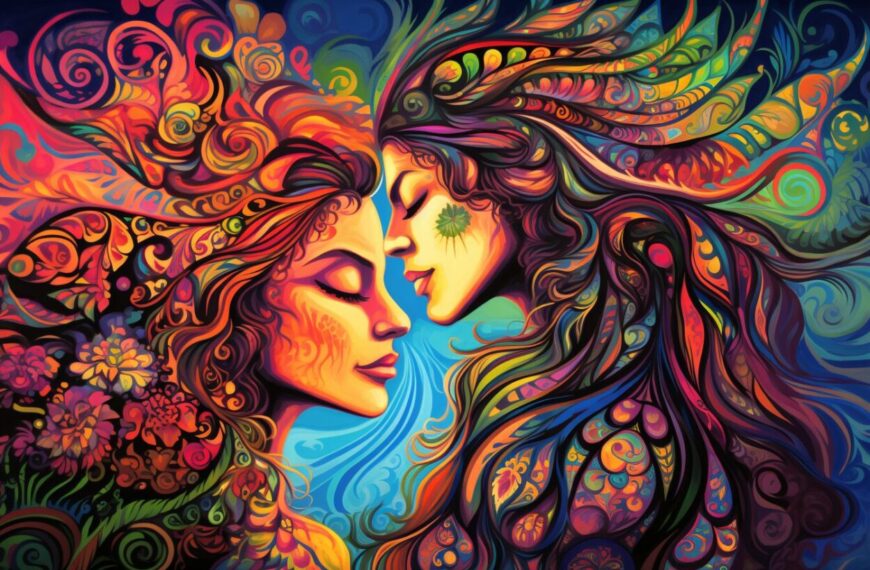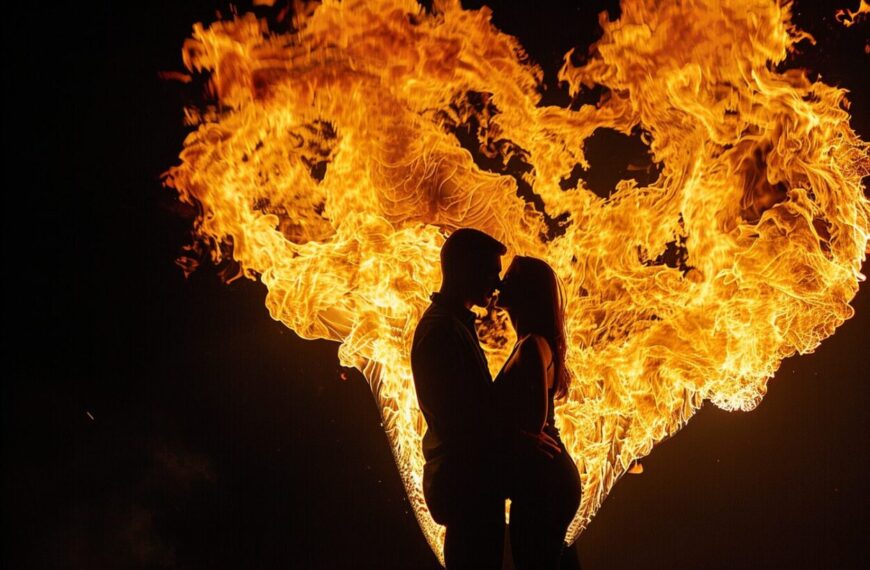Goat Symbolism & Meaning: Ultimate Guide
The goat symbolism and meanings include nourishment, sexual vitality, fertility, aspiration, strength and resilience, the Devil, and spiritual sacrifice. Being among the first animals to be domesticated, goats have become familiar to people across diverse cultures. They provide humans with essential resources like milk, meat, and hides, contributing great values to human life. Most importantly, goats have been used in religious and ceremonial sacrifices as a means to appease gods or spirits, seeking blessings and protection. The symbolic meaning of goat is incredibly deep.
In this article, we will explore the goat symbolism, uncovering its fascinating impact on societies and cultures throughout history. Moreover, we’ll investigate the spiritual importance attached to the goat species.
- Popular Goat Symbolism Around The World
- Goat Symbolism In Christianity
- Goat Symbolism in Greek and Roman Mythology
- Goat Symbolism in Hinduism
- Goat Symbolism and Meaning In Celtic Culture
- Goat Symbolism In Chinese Culture
- Goat Symbolism in Norse Mythology
- Spiritual Meaning Of Goat
- Dream Of Goat Meaning
- Related Posts
Popular Goat Symbolism Around The World
1. Nourishment
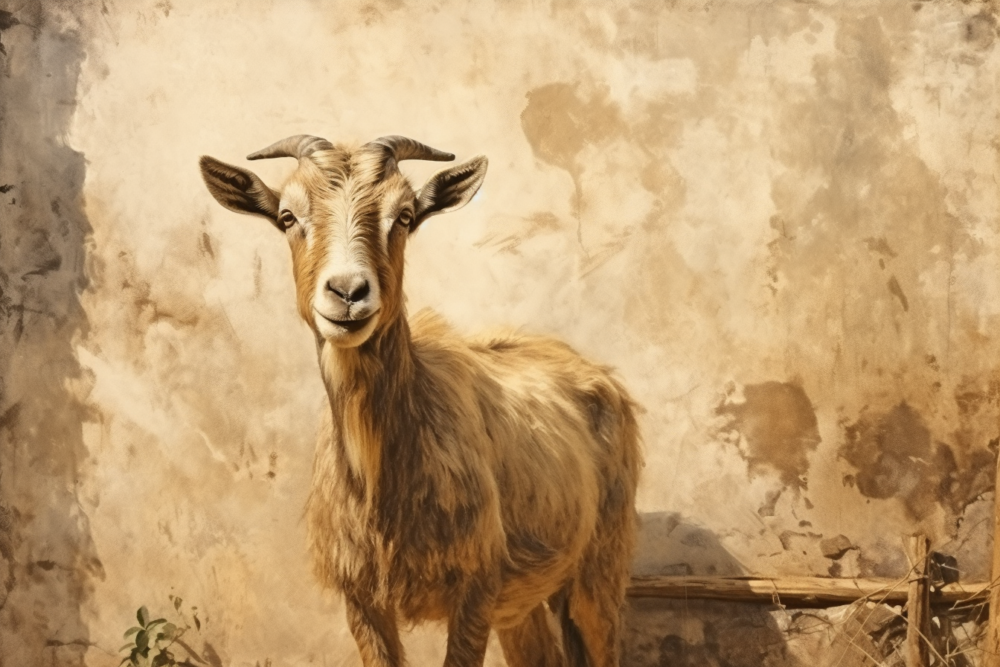
Goat farming plays a crucial role in small-scale agriculture, particularly in Asia and sub-Saharan Africa. Goats provide local communities with meat and milk, serving as a valuable source of income and food security. They are adaptable to various environments and require less food, making them a preferred choice for small farmers worldwide.
Moreover, goats offer numerous benefits, including improved nutrition, economic empowerment, and resilience in times of crisis. They are versatile animals, providing meat, milk, fiber, and even fertilizer. Goats can be found in diverse breeds and thrive in extreme conditions. Goat meat and milk are widely consumed, with goat cheese gaining popularity in developed countries due to its rich flavor and nutritional value. Goats are interesting and friendly creatures and have played major roles in human life for thousands of years, hence their symbolism as a good source of nourishment.
2. Sexual Fertility
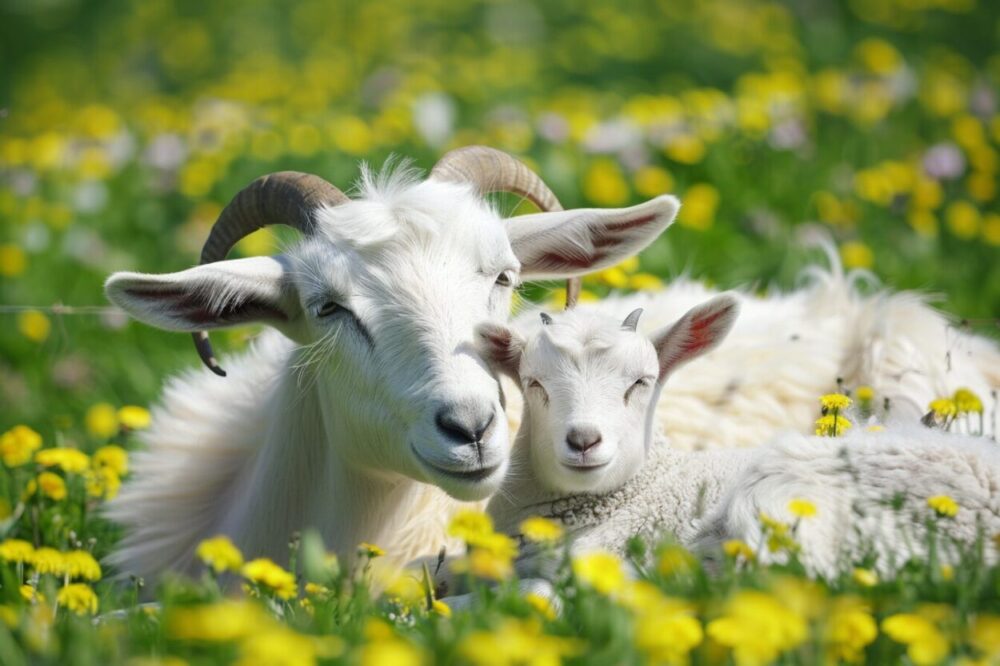
Goats have long been associated with fertility as they are extremely prolific breeders, capable of reproducing multiple times a year and giving birth to multiple offsprings in each pregnancy. Their high reproductive rate symbolizes abundance and the ability to multiply in great numbers.
Usually it is the male goats that carry such symbolism of sexual virility. Male goats have a particularly frequent and continuous mating frequency, unlike other animal species. Except when the male goat is sick, it can engage in continuous mating. The special thing is that each mating session of the male goat is quick and ejaculates very little, so it can mate continuously.
Read More: Symbols of Growth and Progress
Approximately 5-10 minutes after mating with one female goat, it can mate with another female goat and still remain healthy. Female goats usually experience estrus every 18-20 days, with each estrus phase lasting 2-3 consecutive days. Interestingly, during estrus, the female goat’s body emits a distinctive scent, which intensively stimulates the sexual desire of the male goat.
Goat meat have even been rumored to enhance sexual desire, but there is not enough scientific evidence to support this though, but it is easy to see how people arrive at this association. Goats have often been depicted as sexually active and spirited creatures in mythology and folklore. Their lively and energetic nature has been linked to fertility and virility.
3. The Devil
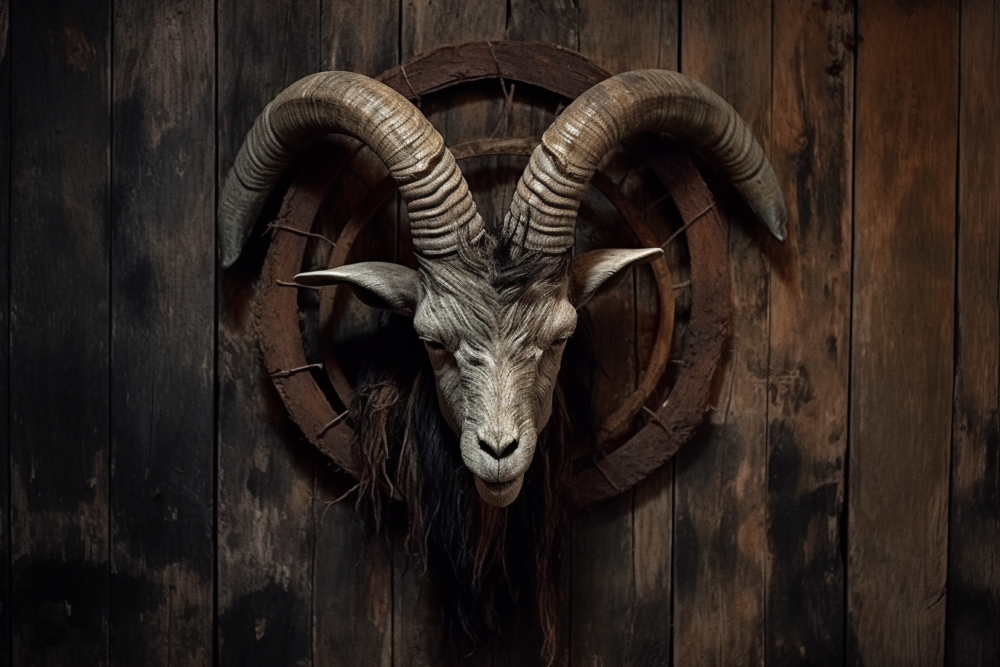
The Baphomet was originally a deity worshipped by a medieval Christian military order founded in the 12th century called the Knights Templar, and its image has been popularized in many occult traditions, then in popular culture. The Baphomet is often depicted as a figure with a goat’s head, human body, cloven hooves, among with many other symbolic elements (bat wings, skulls, etc). It has become the imagery of Satan.
The goat symbolism in Baphomet represents various concepts, including duality, fertility, wisdom, and the balance between opposing forces. Baphomet’s goat-like features are often interpreted as a representation of the primal and instinctual nature of humanity.
But why was Satan depicted as a goat?
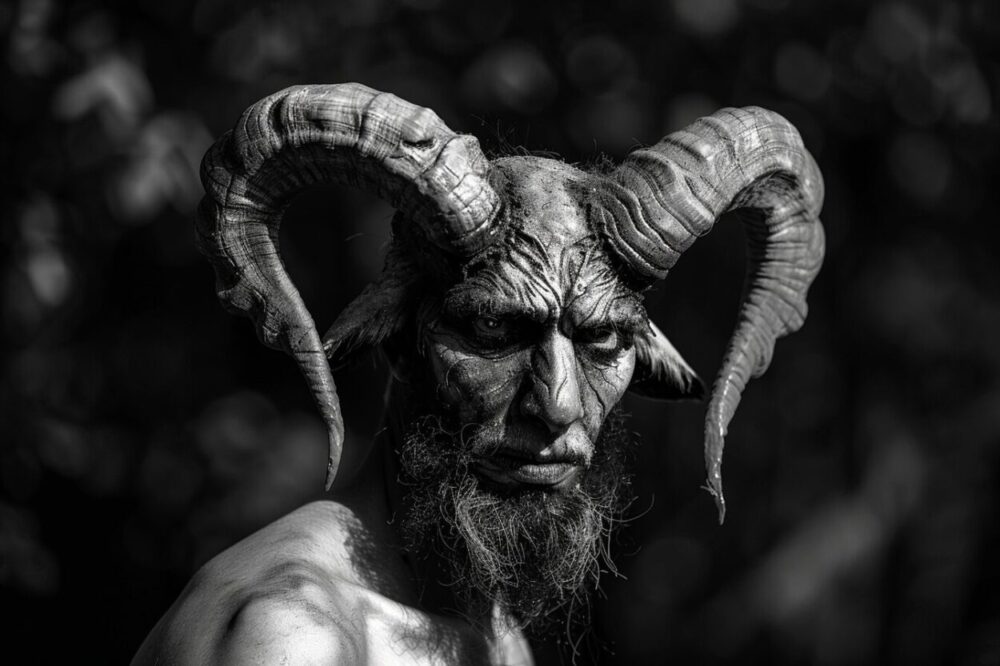
The goat’s devil symbolism stems from its behavior, associated with lust and aggression. They are lustful creature, often engaging in headbutting and constant readiness to mate, which are considered sinful acts. Along with its symbolism of having strong sexual desires, the goat has also been associated with the uncontrolled primal energy of humans. Its eyes have slanted, square pupils because of this lustful nature.
Goats are believed to be so hot-tempered that its blood can dissolve diamonds. The goat’s reputation is further tarnished by Christ’s depiction of the last judgment, where the goats are placed on the left and condemned to hellfire, while the sheep are allowed to live on, referencing a separation of the evil from the righteous. Jewish practices, like Yom Kippur, involved taking a goat away to the desert far away where it will left to die, representing the destruction of the devil.
Read More: Snake Symbolism Around The World
4. Strength and Resilience
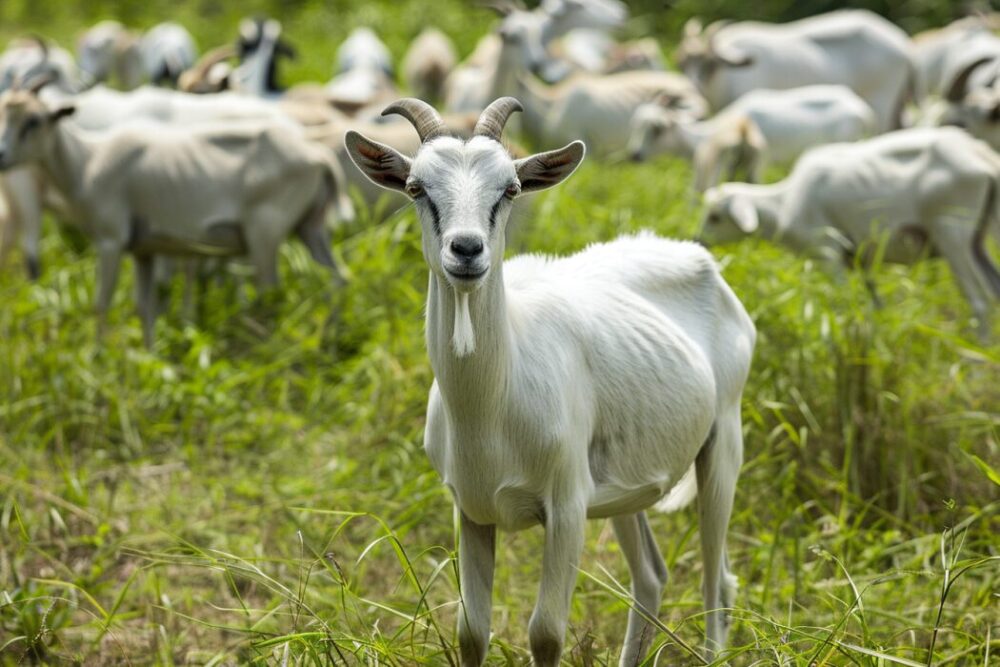
Despite all of this, goats are still strong and resilient creatures. Goats are agile foragers, capable of searching large areas for scarce plants. Their flexible lips and tongues allow them to select the most nutritious plant parts, even in thorny areas. They can stand on their hind legs and stretch to browse tree leaves, and are even able to climb trees to reach their preferred parts.
Goats can thrive even in rough, mountainous terrain that sheep and cattle tend to avoid. They have a wonderful ability to climb almost vertical cliffs that seem impossible its size.
Read More: Symbols of Strength Across Cultures
Another interesting fact is that goats are sociable creatures, but they are not flock-oriented like sheep. This adaptability represents their ability to overcome obstacles and find balance in difficult situations, enabling them to endure harsh climates and limited food sources. They have the inner strength and ability to sustain themselves even in challenging circumstances.
If you see a goat come into your life or appear in your dreams, it may carry a symbolic message related to strength and resilience. The presence of a goat is a reminder to unlock your inner strength and face challenges with determination. You have the power from within to navigate difficult situations with grace and adaptability, just as goats maneuver through such challenging landscapes.
Read More: Popular Symbols of Resilience
5. Sacrifice For The Divine
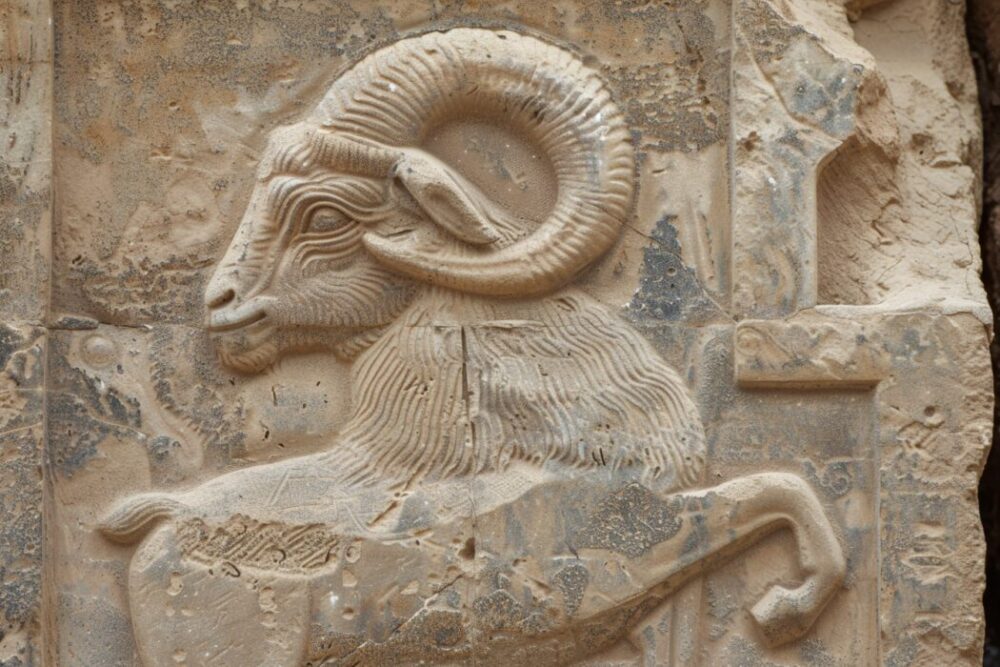
Animal sacrifices, particularly goats, have played a significant role in religious practices throughout history. In ancient Greek and Roman cultures, goats were offered to deities such as Dionysus, Apollo, and Aphrodite, while followers of Artemis and Juno abstained from sacrificing goats. The ritual involved adorning the goats, leading them in a procession, pouring water on their heads, and then swiftly slaughtering them.
Goats were often chosen as sacrificial animals for several reasons. As we have mentioned, goat were symbols of fertility, virility, and abundance, making them suitable offerings to appease gods associated with these aspects. The act of sacrificing a goat was believed to establish a connection between the human world and the divine realm, offering a gift to the gods and seeking their favor or protection.
Read More:
Additionally, goats were considered valuable and desirable animals, so sacrificing them demonstrated a significant act of devotion and commitment. The ritual sacrifice of goats was a way to express religious devotion, seek blessings, and maintain a harmonious relationship with the divine.
6. Goats In The Sign Of Capricorn: Leadership
Goats, known for their agility and sure-footedness, are considered hardy and gregarious animals. In astrology, the sign of Capricorn is associated with the mountain goat, symbolizing their slow but steady approach to success. Interestingly, the sign Capricorn is exactly the “Devil” Tarot card, which further emphasizes the goat symbolism.

Capricorns are seen as loners with introverted characteristics, finding security in high places. They are hardworking visionaries and leaders known for their poise and talents. Notable Capricorns like Dolly Parton, Michelle Obama, and John Legend. These people have their own unique blend of confidence and humility. They value honesty and loyalty in their friendships, though they don’t shy away from expressing their disapproval.
Capricorns offer practical solutions and ideas for improvement. They are doers who make things happen, even amidst busy schedules. Despite their own responsibilities, Capricorns prioritize the needs of their close companions.
In astrology, the sign of Capricorn is also ruled by Saturn, a planet associated with discipline, limitation, and boundaries. While not inherently evil, Saturn’s tough lessons and restrictions can be viewed as a type of “testing” that mirrors some of the challenges traditionally associated with the Devil. This connection with challenge, ambition, and materialism could also contribute to the association of the goat with darker themes.
Goat Symbolism In Christianity
Goats symbolize sin in Christianity. As we have explored, the scripture associates goat-like features with Satan, drawing parallels between demons and physical attributes of goats.
In Leviticus 16 particularly, God instructs the Israelites to transfer their sins onto a goat sent into the desert, which symbolizes Satan’s dwelling place. The death of this goat symbolizes the victory against the evil forces.
This how the Bible describes the event:
“Then Aaron shall lay both of his hands on the head of the live goat and confess over it all the iniquities of the sons of Israel and all their transgressions in regard to all their sins; and he shall lay them on the head of the goat and send it away into the wilderness by the hand of a man who stands in readiness. The goat shall bear on itself all their iniquities to a solitary land; and he shall release the goat in the wilderness.”
The Bible uses the symbol of goats and sheep to illustrate the separation and judgment of people on the final day. Those who lived righteously are represented as sheep, while those who didn’t follow God’s teachings are depicted as goats destined for eternal fire.

However, goats in Christianity do not entirely mean evil and sin. The goat symbolism for nourishment also appeared in the Bible. In Proverbs 27:27, Solomon emphasizes the abundance and nourishment that goats’ milk provides for the family and servants. The mention of goats’ milk highlights the importance of fulfilling basic needs and the responsibility of providing for one’s family.
Goat Symbolism in Greek and Roman Mythology
1. Panes
Panes were spirits of the mountains and pastures who protected goat herds and sheep flocks. They were depicted as men with goat-like features, such as goat feet, horns, tail, beard, snub nose, and ears. Sometimes, they had actual goat heads. As fertility spirits, they were often shown with erect genitalia. The Panes were associated with the god Pan and closely linked to the Satyroi (Satyrs), who had donkey tails and ears, in contrast to the goat-like features of the Pan.
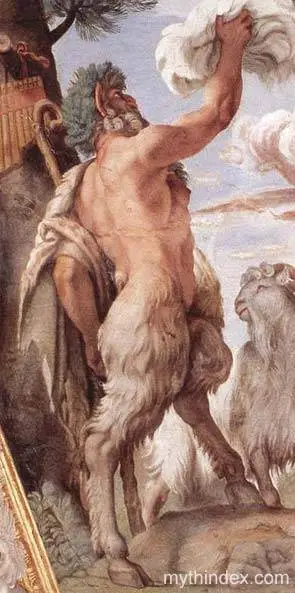
Panes symbolize the protection and guardianship of goat herds and sheep flocks in Greek mythology. They are associated with the natural and wild aspects of the mountains and pastures, embodying the connection between humanity and nature. As fertility spirits, they also represent the abundance and vitality of the land, as well as the wild and instinctual side of human nature, as their goat-like features and behavior reflect untamed and primal qualities.
2. Zeus and the Goat Nurse Amalthea

In Greek mythology, Zeus, the king of the gods, was believed to have been nurtured and protected by a goat named Amalthea. According to the myth, when Zeus was an infant, his father Cronus feared that he would overthrow him, so he devoured his children. To protect Zeus, his mother Rhea hid him in a cave on the island of Crete and entrusted him to the care of Amalthea.
Amalthea, often depicted as a divine goat, provided nourishment to Zeus by offering her milk. Some versions of the myth even describe Amalthea as possessing a magical horn, known as the “Cornucopia,” which could provide an endless supply of food and abundance.
In gratitude for Amalthea’s care and protection, Zeus later transformed her into a constellation in the night sky, known as Capricorn. The story of Zeus and the Amalthea goat highlights the themes of nurturing, protection, and divine providence in Greek mythology.
3. Pan
Pan was the god of the wild, shepherds, flocks, nature, and rustic music, often depicted with the legs, horns, and beard of a goat. He roamed the forests, played his reed pipes, and was closely associated with the untamed aspects of nature, including the sexuality and chaotic energies that were often attributed to rural and wild spaces. Pan’s existence and worship were tied to natural cycles and fertility rites, which often included elements of ritualized sexuality or celebration of life’s vitality.
Pan was also a mischievous god, sometimes causing panic (a word derived from his name) and fear when startled or angered. His association with the wilderness, sexuality, and animal instincts made him a complex figure, embodying both the pleasures and dangers of natural life outside the control of civilization.

As Christianity spread throughout Europe, particularly during the early Middle Ages, many of the native pagan religions and their deities were either absorbed or demonized by the Christian worldview. Pan’s wild and uncivilized nature, combined with his association with the natural world and sexuality, made him an easy target for demonization. Over time, Pan’s image—goat horns, hooves, and a lustful, chaotic demeanor—became associated with the Devil, who in Christian theology represents rebellion against divine order and the embodiment of sin.
4. Faun
Fauns are Roman woodland spirits associated with the god Faunus. They have a human torso, goat lower body, and enjoy music and dancing. They are generally cheerful and benevolent. In Roman mythology, fauns are distinct from Panes, the wild and drunken followers of Dionysos. While fauns have hooves, Panes originally had human feet. Female fauns are less prominent in ancient mythology, with the goddess Bona Dea being an exception.
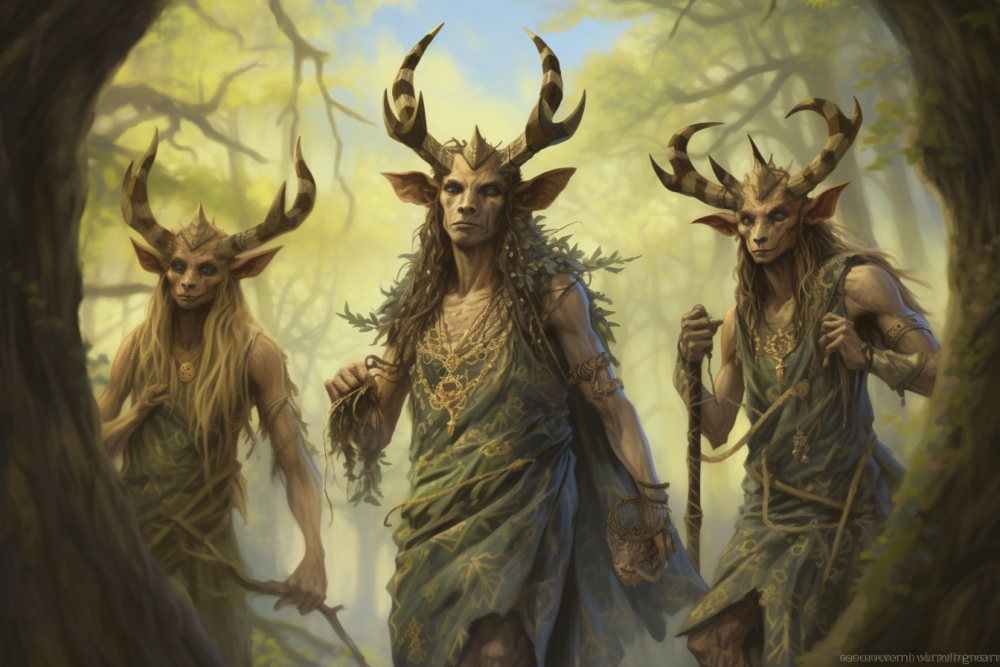
Goat Symbolism in Hinduism
1. Goats As Vehicle of Agni
Agni, the Hindu fire god, is the protector of humanity and the home. He encompasses various forms of fire, including the sun, lightning, and sacrificial fire. Agni is omnipresent but not directly worshipped today. He is a witness to important actions and is invoked in Hindu ceremonies like marriages.
With flaming hair and riding a goat, Agni is easily recognizable in Hindu art. Agni had the responsibility of carrying offerings from the humans to the Gods, but he was scared to do this job because his three brothers died while doing it. So, Agni hid in the underground waters. Sadly, the fish told the gods where he was hiding. As punishment, Agni put a curse on the fish, making them easy to catch for humans.
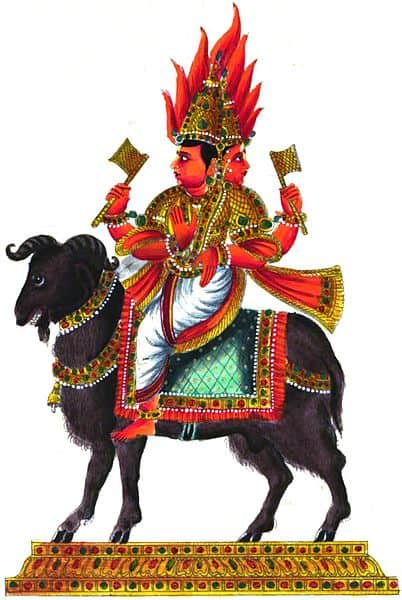
In another version of the story, it was frogs, elephants, and parrots that found Agni and revealed his hiding place. The gods punished them by making their voices strange and distorted forever. In that version, Agni’s final hiding place was in a sami tree, making it a sacred place for fire in Hindu rituals, and people use its wood to make fires. Agni eventually agreed to do his duty again but asked for a part of the offerings he carried as a reward, and he also asked for eternal life. The gods granted his requests.
2. Daksha: Goat-headed Deity
Daksha plays a significant role in Hindu mythology, with various stories and symbolism associated with him. He is considered one of the prajapatis, the divine agents of creation. In his iconography, Daksha is depicted as a man with a stocky body or sometimes with the head of a goat.
One notable story involving Daksha revolves around his daughter Sati and her husband Shiva. Daksha held a grand yajna (fire-sacrifice) but deliberately excluded Sati and Shiva from the invitation. This act of disrespect towards Shiva angered Sati, who was furious. The incident led to the beheading of Daksha by Virabhadra, an attendant of Shiva. However, Daksha was later resurrected with the head of a goat.
3. Naigamesha

Source: Wikipedia
Naigamesha is a deity from Hindu mythology, particularly associated with fertility, protection of children, and childbirth. He is a relatively obscure figure but holds significant importance in some specific rituals and mythological contexts. What makes Naigamesha intriguing is his association with both children and the animal form of a goat or ram. His representation, often with a goat’s head, links him to themes of fertility, creation, and transformation, paralleling other deities across cultures that are tied to goats or ram-like imagery.
Goat Symbolism and Meaning In Celtic Culture
1. Cernunnos
Cernunnos is a deity from Celtic mythology associated with wild nature and wildlife. He is often depicted as a bearded man with deer antlers, symbolizing his connection to animals and fertility. It is believed that he rules over pristine natural places and has the ability to bring wild creatures together in harmony. Cernunnos is also considered a god of life, creation, and fertility, as nature is seen as the source of all living beings. His stories remind us of the importance of respecting and honoring the natural world that surrounds us.

2. Glaistig
The glaistig is a Scottish mythological ghost known as a fuath. It takes various forms, appearing as a beautiful or monstrous woman, a half-woman half-goat like a faun or satyr, or simply as a goat. The lower part of its hybrid form is often concealed by a green robe. The glaistig is both benevolent and malevolent, luring men to their demise or protecting cattle and herders. Legends depict offerings of milk to show gratitude, while stories also connect the glaistig to hunting and deer protection. It is a mysterious and rare apparition with haunting cries and wails.
Goat Symbolism In Chinese Culture
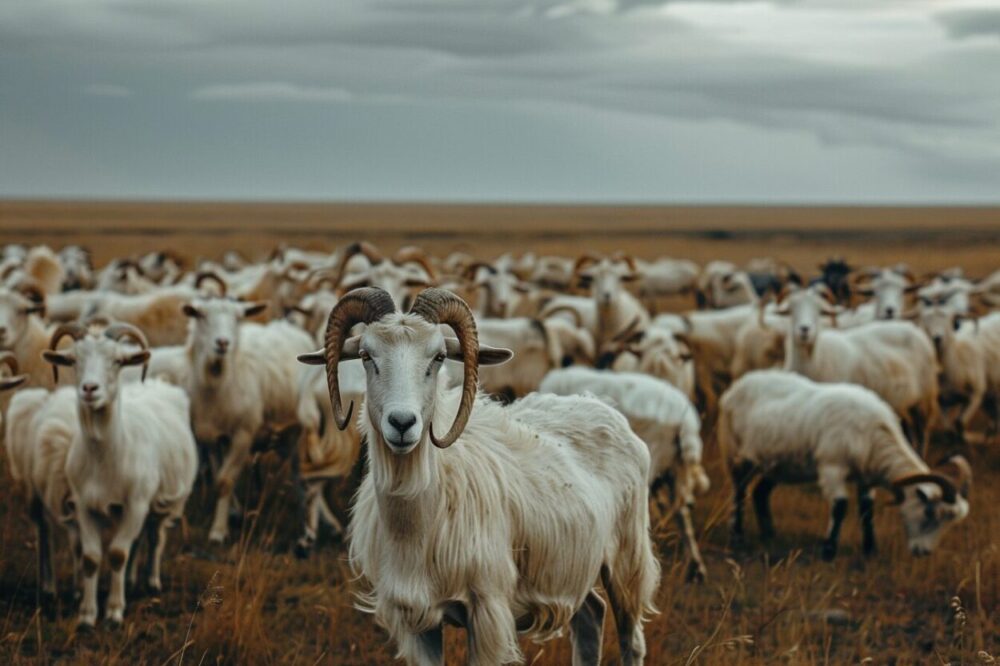
In Chinese culture, goats hold significant symbolism and cultural importance. They are associated with several positive qualities and are considered auspicious animals. The goat, particularly the sheep, represents harmony, kindness, and gentleness. It is also associated with wealth and abundance, as the Chinese character for “sheep” is pronounced similar to the word for “auspicious” or “fortunate.” The goat is often depicted in Chinese art and folklore, representing good fortune, filial piety, and a peaceful demeanor. During the Chinese zodiac, the Year of the Goat is believed to bring harmony and prosperity.
Year Of The Goat
People born in the Year of the Goat are commonly regarded as mild-mannered, kind-hearted, and just. They possess a gentle exterior but are internally resilient and assertive, valuing their own opinions. With their delicate thinking, creativity, and perseverance, they easily acquire professional skills.
Despite their preference for being in groups, they prefer to avoid the spotlight and instead spend ample time lost in their own contemplations. Goats have a penchant for investing in fashionable items that enhance their appearance, but this does not make them snobbish, as they still appreciate the simple pleasures in life.
Goat Symbolism in Norse Mythology
1. Heidrun
In Norse mythology, Heidrun is a mythical goat that resides in Valhalla, the great hall of fallen warriors. It feeds on the leaves of the World Tree, Yggdrasil. The World Tree is believed to connect the different realms in Norse cosmology, and Heidrun’s nourishment from it symbolizes the connection between life, sustenance, and the divine.
Heidrun’s milk is said to have the remarkable ability to produce an endless supply of mead, a fermented beverage associated with celebration and inspiration. It is a vital source of sustenance and pleasure for the warriors in Valhalla. Heidrun’s presence in Valhalla ensures that the fallen warriors can enjoy the everlasting revelry, while other warriors feast in preparation for the final battle, Ragnarok.
Heidrun represents the idea that in the realm of the gods, there is an inexhaustible source of nourishment and pleasure, reflecting the rewards and honor bestowed upon the fallen heroes in Valhalla.
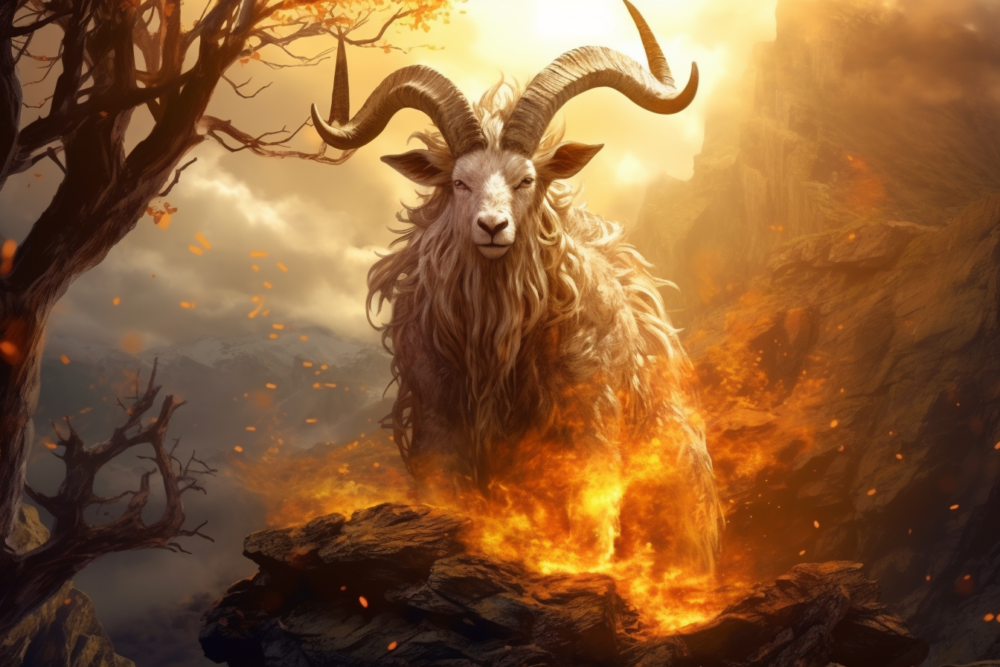
2. Tanngrisnir and Tanngnjóstr
In Norse mythology, Tanngrisnir and Tanngnjóstr are Thor’s loyal goats who pull his chariot. They possess immense strength, enabling Thor to travel across realms with thunderous hooves. One of the remarkable aspects of these goats is their regenerative nature. After a day of travel and reaching their destination, Thor would slaughter them for a meal. However, the next morning, the goats would be restored to life, unharmed and ready for the next journey. This cycle repeats, providing Thor with a continual source of sustenance.
Thor emphasizes their preservation and warns against wastefulness, showing gratitude for their regenerative powers. The stories of Tanngrisnir and Tanngnjóstr highlight the goat symbolism of strength, nourishment, and resilience.
3. Yule Goat
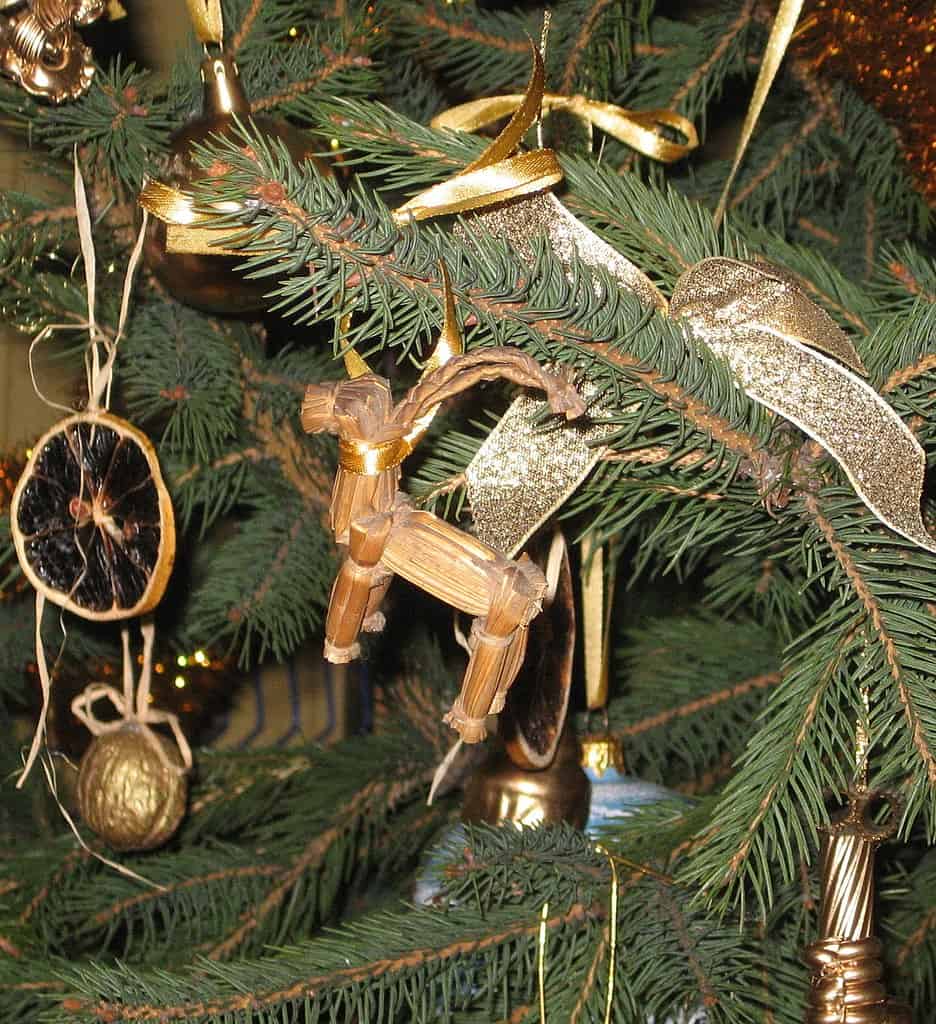
The Yule Goat, also known as Julbock or Julebukk, is a significant figure in Scandinavian folklore associated with Christmas. It has various tales and customs surrounding it.
In some areas, the Yule Goat is believed to have a gift-giving role, similar to Santa Claus. It visits homes during Christmas and leaves presents for well-behaved children. Another tradition involves crafting straw or wooden Yule Goats as Christmas decorations, symbolizing luck and protection during the festive season.
The Yule Goat has its origins in ancient pagan traditions, particularly in Norse mythology, where it is linked to the chariot-pulling goats of the god Thor. Over time, the Yule Goat became integrated into Christian Christmas celebrations. Additionally, Yule Goat processions are organized in certain Scandinavian towns, where people dress up as the Yule Goat and parade through the streets, spreading joy and creating a festive atmosphere. Some regions also associate the Yule Goat with playful pranks, adding an element of fun and humor to the tradition.
Spiritual Meaning Of Goat

The goat is universally recognized as a symbol of strength and courage, portrayed through its robust horns and confident stance, embodying resilience and determination in the face of adversity.
Being closely associated with nature, the goat represents the earth, fertility, and abundance. It symbolizes our primal instincts and our intrinsic connection to the natural world, acknowledging the cycles of birth, growth, and renewal.
In certain pagan and occult traditions, the goat’s head, particularly when adorned with an inverted pentagram, embodies spiritual knowledge, magic, and esoteric wisdom. It often relates to figures or deities associated with darkness and transformation.
In other spiritual and religious contexts, the goat’s head symbolizes sacrifice and atonement, reflecting ancient rituals where goats were offered as offerings to seek forgiveness or appease deities. The duality of nature is encapsulated in the goat’s head, encompassing both gentle and fierce qualities. This symbolizes the significance of balance, harmonizing opposing forces such as light and darkness, masculine and feminine, and the earthly and spiritual realms.
Read More: Symbols of Harmony in Cultures
Dream Of Goat Meaning
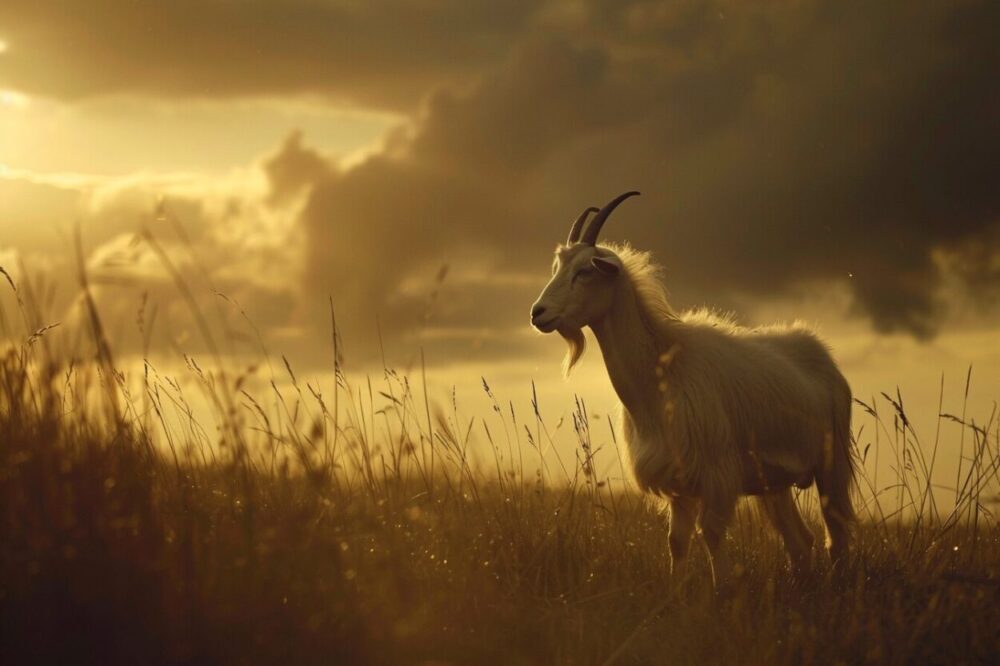
Dreams involving goats, mountain goats, or herds of goats can hold various meanings, and they are highly personal to the dreamer. Thus, there isn’t a definitive answer as to what a goat dream signifies. Dreams may serve as a way for our minds to process lingering thoughts or offer comforting experiences. Additionally, unsettling or anxious dreams can signal the need to confront suppressed aspects of our subconscious. Moreover, dreams can serve as messages from spirit guides and other souls.
To comprehend the significance of your goat dream, it is crucial to reflect on the major goat symbolism and the emotions evoked within the dream. This introspection can provide valuable insights into the messages embedded in the dream.
